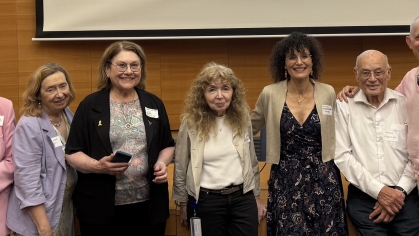Unlocking the Mysteries of Orgasm
For a sensory-behavioral process that garners so much public interest, it’s remarkable how little neuroscientific research has focused on understanding orgasm.
Even neuroscientist Barry R. Komisaruk, who now studies brain activity during sexual response and orgasm, was pursuing other research when an “incidental finding” revealed that vaginal stimulation blocked pain in laboratory rats. That led Komisaruk, Board of Governors Distinguished Service Professor in Psychology at Rutgers University in Newark, to see if the same pain-blocking occurred in women (it did) and to look for the nerve pathway at work.
At that time, genital sensation was thought to reach the brain only through the spinal cord. Komisaruk studied five women with severed spinal cords, injuries that left them paralyzed in their lower torsos. During the research, the women used vaginocervical self-stimulation and felt both stimulation and pain blockage. Three experienced orgasm.
“It was very emotional,” Komisaruk recalls. Some of the women cried. “It was a surprise to me and them because their doctors had told them after their injury that their sex life is over; they wouldn’t be able to feel genital sensations.”
Komisaruk and his colleagues used functional magnetic resonance imaging (fMRI) to determine how genital sensation was signaled to the brain in women without an intact spinal cord. Imaging revealed activation of an alternative pathway through the vagus nerve, a long cranial nerve that had never been shown to extend into the pelvis in humans.
The findings, published in Brain Research (Oct. 22, 2004), “gave neural validation that they [the women] must be feeling sensation,” says Komisaruk. “It turned out to be the world’s first evidence of where orgasms occur in women’s brains.”
Since then, he has been using new technology to identify the sequence of brain regional activity leading up to, during and after women’s orgasms and map where input from the clitoris, vagina, cervix and uterus project in the brain. He also is mapping men’s genital sensations and orgasms. The data so far show that the penis, scrotum and testicles project sensation to different brain regions.
Komisaruk’s current work could help people who do not experience orgasm. “Virtually nothing is known about anorgasmia in men or women, other than that SSRIs (selective serotonin reuptake inhibitor antidepressants) have a powerful effect on blocking orgasm,” he says.
He and his colleagues are developing a method of neurobiofeedback to enable people with genital sensation but not orgasm to view “their own brain activity in real time and see where the blockage occurs.” Anorgasmic individuals possibly could learn to bypass the blockage by controlling the related brain region.
His work has led to a side expertise in persistent genital arousal disorder (PGAD), a rare but debilitating condition in women. Sufferers are often dismissed as having a problem that is “all in their heads.” Through imaging, Komisaruk has shown they have real problems—abnormal activity in certain brain regions and a high incidence of nerve cysts that appear to contribute to PGAD.
Komisaruk believes it’s important for researchers to pay attention to—and pursue—findings that are unplanned or surprising.
That’s how his research on genital stimulation and pain blockage began, leading to evidence that brain areas activated by pain are the same ones activated by orgasm. From there, it showed the more pleasurable the genital stimulation, the greater the pain blockage. “There are intriguing connections between pleasure and pain in the brain that we do not yet understand, but we are working on it,” he says.


